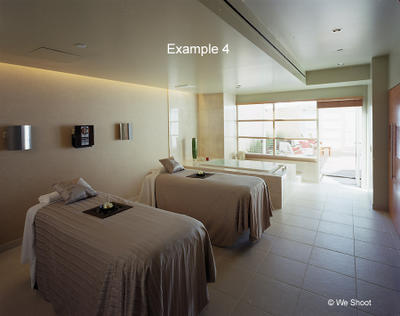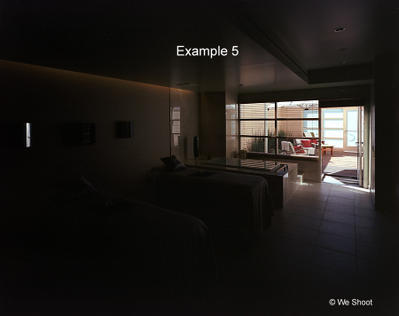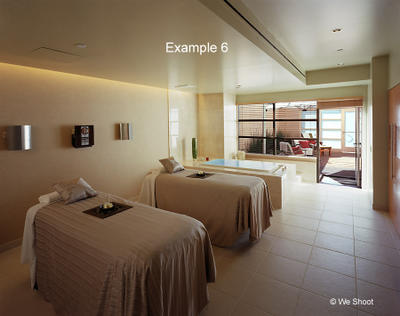If you are new to this blog, it probably would be to your benefit to start at the bottom post and work your way up. This blog is sponsored by weshoot.com, where you may see many examples of architectural photos, and bilbord.com, where you can see extensive retouching and enhancement of building images. Its purpose is to give anyone who wishes to photograph building interiors and exteriors the knowledge of how to do so correctly, and what to do in post-production work to make their images better and more professional-looking. I will periodically be adding to this blog. Please note that I do not allow blogspamming in comments, and any attempt to do so will wind up with the comment being removed.
Thursday, September 22, 2005
The Double-Exposure:
Many years ago, while cutting our teeth on weddings, a double-exposure meant two exposures on the same piece of film. Sometimes mask filters were employed, like a dot and a circular hole. One clear filter had a black dot in some part of it, say, in the center. This was used while taking an image of the dancing at the reception (or other such scene) and would keep part of the film frame unexposed for the second part of the exposure. The camera had a means to keep the film from advancing while the shutter was cocked, and the first filter was replaced by another, this time with circular hole placed where the dot was on the first filter. An exposure was then taken of a close-up of the bride and groom, placing them as presiding over the scene behind them.
In architectural photography, a similar thing can be done in the digital age, whether shooting on film or capturing an image with a digital camera! The reason is a little different, though. If you have lots of money and a crew to assist you on an interior shoot, and are aiming towards the outside windows, you can use neutral-density filtration materials on the windows and cut down the amount of light entering the room from outside. This cuts the contrast between the darkness of the room and the brightness of the outside. This way, the scene outside, be it a garden or a pool area, are not blown out in the image. I will illustrate how to use two negatives to shoot the image and marry them in Photoshop. This can also be done with digital images. This is the poor-man's way to shoot such an image without a crew of grips, and spending money on much neutral-density material. This particular shot would have been hard to do with neutral-density sheeting, as the door to the room was open - no glass. See Examples 4, 5, and 6 below:



Example 4 shows the room, a 4x5 neg exposed to show enough detail in the room, while not changing the mood, which was supposed to be relaxing and soothing. We could have lit the room up to cut the contrast between inside and outside, but it would have ruined the mood. The outside is all but blown out.
Prior planning is everything, and we brought extra film and Polaroids to handle a situation such as this. Example 5 (another 4x5 neg) shows the same image exposed for the light outside the room. This made the room dark and with not enough detail for a finished image. This part of the final image has to be shot at the same aperture as before, as the image will be bigger or smaller in size compared to the first, depending on the aperture. Only the exposure time is less on Example 5 than on Example 4.
Example 6 shows the marriage of the two images, with a bit of a massage in Photoshop, blending the two images. Example 6 is a more pleasing image than Example 4, and closely mimics what we could see with our own eyes while we were in the room.
Plan for these images, and take the exposures necessary to ensure that you will be able to make the image you envisioned.
Many years ago, while cutting our teeth on weddings, a double-exposure meant two exposures on the same piece of film. Sometimes mask filters were employed, like a dot and a circular hole. One clear filter had a black dot in some part of it, say, in the center. This was used while taking an image of the dancing at the reception (or other such scene) and would keep part of the film frame unexposed for the second part of the exposure. The camera had a means to keep the film from advancing while the shutter was cocked, and the first filter was replaced by another, this time with circular hole placed where the dot was on the first filter. An exposure was then taken of a close-up of the bride and groom, placing them as presiding over the scene behind them.
In architectural photography, a similar thing can be done in the digital age, whether shooting on film or capturing an image with a digital camera! The reason is a little different, though. If you have lots of money and a crew to assist you on an interior shoot, and are aiming towards the outside windows, you can use neutral-density filtration materials on the windows and cut down the amount of light entering the room from outside. This cuts the contrast between the darkness of the room and the brightness of the outside. This way, the scene outside, be it a garden or a pool area, are not blown out in the image. I will illustrate how to use two negatives to shoot the image and marry them in Photoshop. This can also be done with digital images. This is the poor-man's way to shoot such an image without a crew of grips, and spending money on much neutral-density material. This particular shot would have been hard to do with neutral-density sheeting, as the door to the room was open - no glass. See Examples 4, 5, and 6 below:



Example 4 shows the room, a 4x5 neg exposed to show enough detail in the room, while not changing the mood, which was supposed to be relaxing and soothing. We could have lit the room up to cut the contrast between inside and outside, but it would have ruined the mood. The outside is all but blown out.
Prior planning is everything, and we brought extra film and Polaroids to handle a situation such as this. Example 5 (another 4x5 neg) shows the same image exposed for the light outside the room. This made the room dark and with not enough detail for a finished image. This part of the final image has to be shot at the same aperture as before, as the image will be bigger or smaller in size compared to the first, depending on the aperture. Only the exposure time is less on Example 5 than on Example 4.
Example 6 shows the marriage of the two images, with a bit of a massage in Photoshop, blending the two images. Example 6 is a more pleasing image than Example 4, and closely mimics what we could see with our own eyes while we were in the room.
Plan for these images, and take the exposures necessary to ensure that you will be able to make the image you envisioned.
Comments:
<< Home
Excellent post. The info that you wrote it seems too interesting for our business, in addition to the images seem very surprising. Like you, we love to share our work with the same passion that unites us. Thank you very good work.
Post a Comment
<< Home
